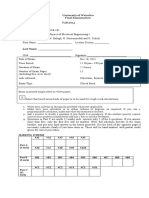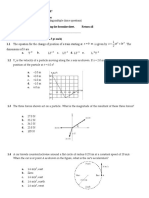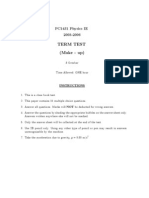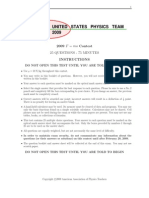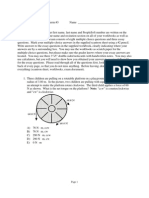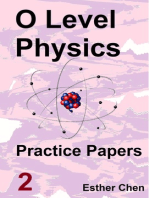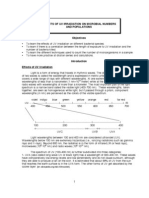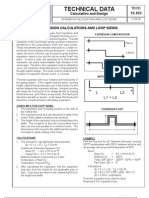Final Exam 2009 SP
Final Exam 2009 SP
Uploaded by
Nick SnyderCopyright:
Available Formats
Final Exam 2009 SP
Final Exam 2009 SP
Uploaded by
Nick SnyderOriginal Description:
Original Title
Copyright
Available Formats
Share this document
Did you find this document useful?
Is this content inappropriate?
Copyright:
Available Formats
Final Exam 2009 SP
Final Exam 2009 SP
Uploaded by
Nick SnyderCopyright:
Available Formats
Physics 10310 Spring, 2010 Final Exam
This is a 2-hour, closed-book exam. The equations and constants you may need are on the last page of the exam. If you wish to use an equation not on the equation sheet, please show how you obtained it. This exam, including the equation sheet has 15 pages. (Make sure none of yours are missing!) You may use a calculator, but remember that an answer, even if correct, is not worth full credit unless you clearly show your work. Neat, organized work is essential for receiving full credit. Answers without units are incomplete. Points will be deducted. The exam consists of ten multiple-choice questions (each worth two points) and eight problems (each worth ten points). You must do the first two problems; however, you only need to do four of the last six problems. There are a total of 80 points on the exam. Each of the six problems should be attempted on a new page of the examination booklet. Please put all of your work, plus the clearly marked final answer in the blue examination booklet. Work or answers written on the exam sheet will not be graded. Before you hand in your exam, please make sure you do the following: 1. Print your name and number on this page and on the cover of the blue book. 2. Indicate on the cover of the blue book the problems you do not wish graded (two problems numbered between 3 and 8). 3. Enter your multiple choice answers in the box on the inside cover of the blue book. Good luck! It has been a pleasure working with you this semester.
1 of 15
Multiple Choice Questions MC 1: For waves, interference refers to which of the following: A. The slowing down of one wave in the presence of another. B. The resultant disturbance of two or more waves at every point in the medium C. The change in wavelength that occurs when two waves cross each other D. The phase change of 180 that occurs on reflection of a wave from a fixed end E. The ability of waves to go around corners MC 2: An object has an initial kinetic energy K. The object then moves in the opposite direction with three times its initial speed. The kinetic energy now is A. B. C. D. E. K 3K -3K 9K -9K
MC 3: Shown below are four arrangements of two blocks. Assume that in each case the blocks are at rest and in contact. If the force A exerts on B is r r r FAB and the force B exerts on A is FBA , for which is FAB the largest? Negative values are smaller than positive values or zero. A. B. C. D. E. Figure 1 Figure 2 Figure 3 Figure 4 All are equal
MC 4: A constant torque of 15 N m acts for 3 s on a system of mass 2 kg. The change in angular momentum of the system during this time is A. B. C. D. E. not possible to calculate since the moment of inertia is not known. zero since the kinetic energy of the system does not change. 90 kgm2/s. 45 kgm2/s. 22.5 kgm2/s.
2 of 15
MC 5: Two identical bowling balls go down different ramps. Both ramps have the same angle of inclination and length. However, one ramp is frictionless, so the ball slides down the ramp, while the other ramp has a high enough coefficient of static friction that the ball rolls without slipping. If the balls are released from rest at the same instance, which of the following statements is true A. Both balls reach the bottom of their respective ramps at the same time. B. The sliding ball reaches the bottom before the rolling ball. C. The rolling ball reaches the bottom before the sliding ball. D. The sliding ball has a greater total kinetic energy. E. The rolling ball has a greater total kinetic energy.
MC 6: A thin spherical shell with a radius of R and a mass of M is located at the origin of a coordinate system. A solid sphere with radius r and mass m with its center located on the x axis at x = 2R as shown. What is the magnitude of the gravitational force exerted on the sphere by the shell? A. F = B. F = C. F =
2
( 2 )
2
22 D. F = 42 E. F = 3
MC 7: If both linear momentum and angular momentum are conserved for a system, which of the following must be true: 1. The sum of the external torques acting on the system must be zero. 2. There can be no internal forces or torques acting on the system. 3. There can be no external torques acting on the system. 4. The total kinetic energy about the center of mass must remain constant. 5. The sum of the external forces acting on the system must be zero. A. 3, 4, and 5 B. 1 and 4
3 of 15
C. 2, 3 and 4 D. 1, 2, 3, 4, and 5 E. 1 and 5 MC 8: A woman sits on a stool that can turn friction-free about its vertical axis. She is handed a spinning bicycle wheel that has u r angular momentum L 0 and she turns it over is, through 180). She thereby acquires an angular momentum of magnitude A. 0 s B. 1 L0 2 u r C. L0 u r D. 2L0 u r E. 4L0
(that
MC 9: Five identical beakers are filled to the point of overflowing, some with objects (all equal in mass) floating or submerged. Which scale has the highest reading? Boat Ice cube Boat Cork tied to floating floating Just water sunk bottom
MC 10: A particle is moving with a speed v(t). The result of the calculation v dt is A. B. C. D. E. displacement (x) acceleration (a) work (W) angular momentum (L) time (t)
4 of 15
5 of 15
Mandatory Problems: You must do both of the following problems. Problem 1: Your clock radio, the same one that failed to awaken you in time for Exam III, usually awakens you with a particularly irritating sound of frequency 600 Hz. One morning it malfunctions and cannot be turned off. In retaliation, you drop it from your dorm window, 15 m above the ground. As you listen with glee to the sound of the radio as it drops, what frequency do you detect just before the radio smashes into the ground? Assume the speed of sound is 343 m/s.
Problem 2: In the arrangement below, an object of mass m is hung over a massless pulley from a very strong cord whose linear mass density is = 0.002 kg/m. The cord is connected to a vibrator operating at a constant frequency, f. The length of the cord between point P and the pulley (both locations considered nodes) is L = 2.0 m. When the mass m is 16.0 kg standing waves are observed. As the mass m is gradually increased, the next lower harmonic mode is not observed until the mass is m = 25.0 kg. a. What is the frequency of the vibrator? b. What is the largest mass for which standing waves could be observed?
6 of 15
Additional Problems: Please choose four of the next six problems to solve. We will only grade four problems, so please indicate on the front of your blue examination booklet which problems you would like us to skip grading. If you fail to indicate a problem for us to skip, we will grade the first four problems attempted in your blue book.
Problem 3: A block of mass m = 2.00 kg starts at a height h = 1.60 m on a frictionless, curved ramp, as shown in the figure. The block is released from rest, slides down the ramp, across the level, frictionless surface, and contacts a spring. If the maximum compression in the spring is 12 cm, what is the spring constant k?
Problem 4: A open railroad car with mass M = 2440 kg is rolling along a straight, level railroad track with a speed of 7.00 m/s. There is no friction on the track and you can neglect air resistance. As the car rolls past grain silo, the silo dumps 1500 kg of grain. (The grain falls straight down.) What is the speed of car after the grain is dumped in?
7 of 15
Problem 5: A block of mass m1 = 5 kg rests on another block of mass m2 = 10 kg which slides on a frictionless table. The coefficients of static and kinetic friction between m1 and m2 are s = 0.6 and k = 0.4. Block m2 is connected to a mass m3 by a massless inextensible string that passes over a massless, frictionless pulley. a. What is the maximum acceleration of m1 that can be achieved with this setup? b. What is the maximum value of m3 so that m1 moves with m2 without slipping?
Problem 6: A uniform sphere of mass M and radius R is free to rotate about a horizontal axis through its center. A string is wrapped around the sphere and is attached to an object of mass m. In terms of g, m and M, derive the expressions for the following: a. The acceleration of the object. b. The tension in the string.
8 of 15
Problem 7: Inspired by the Torricelli tank physics demo, you set out to make the best engineering project ever, as shown in the figure. The project consists of a cylindrical tank filled to a depth of h0 = 1.1 m with water. The tank is fitted with a 0.5 m radius lid, and you can increase the pressure in the tank above atmospheric pressure by placing a mass m on the lid. You drill a small hole in the tank a distance h1 = 0.70 m above floor level. You place a small hoop a distance R = 0.92 m away from the base of the tank. You would like to direct the stream of water to pass precisely through the center of the hoop which is a distance h2 = 20 cm above the floor. How much mass must you place on top of the lid to accomplish this?
Problem 8: It is possible that proton collisions generated by the Large Hadron Collider (LHC) at the CERN lab in Geneva, Switzerland could create black holes. Such black holes would have a very small mass and are expected to evaporate almost instantaneously. However, if they do not evaporate, they could start to grow and cause problems. a. Suppose the black hole is produced at rest at the earths surface. The earths gravity will start to pull the black hole towards the center of the planet. Assume the black hole moves through the earth without being impeded in any way. Write an expression for the black holes acceleration as a function of its distance from the center of the earth. You may assume that the earth is a uniform, solid sphere so that the force of gravity from , . the earth is given by FG = 3 b. Once it reaches the other side of the of the planet, the black hole will come 9 of 15
to rest, and then begin accelerating back towards the center of the planet again. Assuming that it doesnt loose energy, it will oscillate back and forth like this indefinitely. What is the period of the oscillation?
10 of 15
11 of 15
12 of 15
13 of 15
14 of 15
15 of 15
You might also like
- Nuke Prep GuideDocument29 pagesNuke Prep GuideakdevotoNo ratings yet
- Finals - Attempt ReviewcircuitDocument13 pagesFinals - Attempt ReviewcircuitRony Maea40% (5)
- Revision Midterm Exam Physics1 NEWDocument17 pagesRevision Midterm Exam Physics1 NEWBaoduy NguyenNo ratings yet
- 101 FA08 HE2SolvedDocument12 pages101 FA08 HE2SolvedJulio César Macías ZamoraNo ratings yet
- Exam 2012 PDFDocument12 pagesExam 2012 PDFYuChenQianNo ratings yet
- Midterm Exam 2016 2017 01Document4 pagesMidterm Exam 2016 2017 01Bá Phong LêNo ratings yet
- Spring 2008 Qualifying ExamDocument5 pagesSpring 2008 Qualifying ExamrujintoNo ratings yet
- Practice FinalDocument4 pagesPractice FinalChennaiSuperkingsNo ratings yet
- Revision Midterm Exam Physics1 NEWDocument14 pagesRevision Midterm Exam Physics1 NEWBá Phong LêNo ratings yet
- bd9c16d53aeca3667e0b2d0f7e9bb6a9Document7 pagesbd9c16d53aeca3667e0b2d0f7e9bb6a9alanbobby321No ratings yet
- Spring 2009 Qualifying ExamDocument6 pagesSpring 2009 Qualifying ExamrujintoNo ratings yet
- p.1 FizDocument12 pagesp.1 FizredroseNo ratings yet
- Last Name: - : University of Waterloo Final Examination Fall 2014Document13 pagesLast Name: - : University of Waterloo Final Examination Fall 2014YuChenQianNo ratings yet
- Addis Ababa City Administration Education Bureau Addis Abeba Grade 12 Physics Model Examinations GINBOT 2013/MAY 2021Document9 pagesAddis Ababa City Administration Education Bureau Addis Abeba Grade 12 Physics Model Examinations GINBOT 2013/MAY 2021dmc constructionNo ratings yet
- Physics 2007 EUEEDocument8 pagesPhysics 2007 EUEElikinaw demisieNo ratings yet
- Review/Diagnostic Homework, Physics 4304, Dr. Charles W. MylesDocument5 pagesReview/Diagnostic Homework, Physics 4304, Dr. Charles W. MylesNur SyahirahNo ratings yet
- Practice Hookes and SHM SolutionsDocument10 pagesPractice Hookes and SHM SolutionsZhong Huang100% (2)
- PHYS1.1 - MCQ - Midterm - ReviewDocument9 pagesPHYS1.1 - MCQ - Midterm - ReviewNhi Nguyễn NgọcNo ratings yet
- Application of Newton's Second Law: Challenge Problems Problem 1: Painter On A PlatformDocument9 pagesApplication of Newton's Second Law: Challenge Problems Problem 1: Painter On A PlatformBoldie LutwigNo ratings yet
- First Term 11 Sample PaperDocument8 pagesFirst Term 11 Sample Paper18570rmgNo ratings yet
- Fall 2009 Qualifying ExamDocument6 pagesFall 2009 Qualifying ExampaimoNo ratings yet
- Fall 2007 Qualifying ExamDocument6 pagesFall 2007 Qualifying ExampaimoNo ratings yet
- Trial 1 Term1 STPM 2015 Lengkap SMK MantinDocument10 pagesTrial 1 Term1 STPM 2015 Lengkap SMK MantinSouseiseki ChromeNo ratings yet
- 1604025581SAT Physics Subject Test Question Paper 2Document28 pages1604025581SAT Physics Subject Test Question Paper 2hacksufi47No ratings yet
- Part 1. Multiple Choice Questions (4 Points) : CodeDocument4 pagesPart 1. Multiple Choice Questions (4 Points) : Codeminh nguyễnNo ratings yet
- 2022 General RoundDocument20 pages2022 General RoundlowyohannNo ratings yet
- Final Exam W07Document5 pagesFinal Exam W07Malik ANo ratings yet
- Provas - Olimpiada AmericanaDocument48 pagesProvas - Olimpiada AmericanaGabriel Oliveira MartinsNo ratings yet
- PHY G 12 2016E.cmodel Exam (1)Document8 pagesPHY G 12 2016E.cmodel Exam (1)yohanantameneNo ratings yet
- PHYSICS MODEL EXAM FOR G-12 2016 ADDIS KETEMADocument8 pagesPHYSICS MODEL EXAM FOR G-12 2016 ADDIS KETEMAmohammed EshetuNo ratings yet
- Sample Paper 01 (2019-20)Document28 pagesSample Paper 01 (2019-20)Gaurav VasithaNo ratings yet
- NUS Physics PaperDocument6 pagesNUS Physics PaperBilin ZhuangNo ratings yet
- Physics SolvedDocument16 pagesPhysics SolvedAbhijeet Singh PanwarNo ratings yet
- 212 - Problem Sets Complete NEWDocument20 pages212 - Problem Sets Complete NEWBettinamae Ordiales De MesaNo ratings yet
- 8 01l Fall 2005 Practice Exam3Document5 pages8 01l Fall 2005 Practice Exam3Ignasio WakudyanayeNo ratings yet
- Spring 2010 Qualifying ExamDocument7 pagesSpring 2010 Qualifying ExamrujintoNo ratings yet
- PHYSICS Model 2014 G12Document11 pagesPHYSICS Model 2014 G12Kedir MohammedNo ratings yet
- PHY105 20182 Midterm2 VersionaDocument8 pagesPHY105 20182 Midterm2 Versionaemreno514No ratings yet
- Final Fall2013Document15 pagesFinal Fall2013C LNo ratings yet
- Physics Trial Pahang STPM 2008Document14 pagesPhysics Trial Pahang STPM 2008Chloyee LkyNo ratings yet
- 2009 F-MaDocument9 pages2009 F-MaGeorge KongNo ratings yet
- PHY107 SP23 Practice Final ExamDocument10 pagesPHY107 SP23 Practice Final Exammaichi5145No ratings yet
- PhysDocument10 pagesPhysahmedNo ratings yet
- PS#7 Due05302024Document4 pagesPS#7 Due05302024inluculentNo ratings yet
- 1Document1 page1Dani UddinNo ratings yet
- Midterm Exam A1Document3 pagesMidterm Exam A1Bá Phong LêNo ratings yet
- CBSE Class 11 Physics Sample Paper-09 (Solved)Document23 pagesCBSE Class 11 Physics Sample Paper-09 (Solved)cbsesamplepaper0% (1)
- 2003 Qualifying ExamDocument5 pages2003 Qualifying ExamrujintoNo ratings yet
- PHYS161 Test 2 - 2011 - SolutionsDocument8 pagesPHYS161 Test 2 - 2011 - SolutionsGlenice GayleNo ratings yet
- Xi Half 24Document6 pagesXi Half 24mrinalisen28No ratings yet
- 1626957029Rituparna-SAT Physics Practice Paper 13Document15 pages1626957029Rituparna-SAT Physics Practice Paper 13dodo.thetruelegionNo ratings yet
- Midterm3 KeyDocument6 pagesMidterm3 KeyJeremy LevyNo ratings yet
- Question Paper JeeDocument20 pagesQuestion Paper JeeSourabhThakurNo ratings yet
- Problems MechanicsDocument28 pagesProblems MechanicsdebasijNo ratings yet
- Soalan Phy 1 2019 Kelantan Modul 2Document11 pagesSoalan Phy 1 2019 Kelantan Modul 2Lee Jia XuanNo ratings yet
- 04 - Fl18_ Finaltest_allq - For PrintDocument8 pages04 - Fl18_ Finaltest_allq - For Printibrahimalhabsi118No ratings yet
- 2009T1Document8 pages2009T1smk1992No ratings yet
- Fall 2004 Part 1Document5 pagesFall 2004 Part 1eka123No ratings yet
- O level Physics Questions And Answer Practice Papers 2From EverandO level Physics Questions And Answer Practice Papers 2Rating: 5 out of 5 stars5/5 (1)
- @@@ Geothermal-WellsDocument44 pages@@@ Geothermal-WellsstarykltNo ratings yet
- Growatt Catalog GlobalDocument55 pagesGrowatt Catalog Globalluz osorioNo ratings yet
- Baird, George - Energy Performance of buildings-CRC Press (1984)Document217 pagesBaird, George - Energy Performance of buildings-CRC Press (1984)Aymane KaraniNo ratings yet
- Smart Grid MarketingDocument57 pagesSmart Grid MarketingaliciakNo ratings yet
- Mass Transfer - Ii (KCH 601) Unit - 2: Vinay Mishra Deptt of Chemical Engineering IET LucknowDocument10 pagesMass Transfer - Ii (KCH 601) Unit - 2: Vinay Mishra Deptt of Chemical Engineering IET LucknowkrishnaNo ratings yet
- Eim-8 Module 4Document25 pagesEim-8 Module 4ruth eliezer alcazarNo ratings yet
- MATRADE Greentech PDFDocument148 pagesMATRADE Greentech PDFSF GohNo ratings yet
- Modelling A Pre-Chamber Injection System For Natural Gas Engines in Matlab-Simulink EnvironmentDocument106 pagesModelling A Pre-Chamber Injection System For Natural Gas Engines in Matlab-Simulink EnvironmentManfredi NotarangeloNo ratings yet
- Blueprint XXI Web 180913Document187 pagesBlueprint XXI Web 180913BruegelNo ratings yet
- Electrical Science Manual 2023Document55 pagesElectrical Science Manual 2023ANSHUL SINGHNo ratings yet
- Módulo Ponte H VNH 5019Document38 pagesMódulo Ponte H VNH 5019Kamylla C. OliveiraNo ratings yet
- VIII - Science Assessment 1Document3 pagesVIII - Science Assessment 1Komala SravanamNo ratings yet
- S700 - AlumilDocument29 pagesS700 - Alumilhakangns34No ratings yet
- 双语:中国时政术语汉英对照(2012 2018年)Document32 pages双语:中国时政术语汉英对照(2012 2018年)Ted TsieNo ratings yet
- Claremont COURIER 5-2-14Document36 pagesClaremont COURIER 5-2-14Claremont CourierNo ratings yet
- CELMaharashtra 44 MWDocument81 pagesCELMaharashtra 44 MWGururaj KanjikerNo ratings yet
- UNIT - 3 BCME FinalDocument26 pagesUNIT - 3 BCME FinalAnith Kumar ReddyNo ratings yet
- NCSC Activity Guide BookDocument202 pagesNCSC Activity Guide BookAMIT AGARWAL100% (3)
- Effect of Uv On BacteriaDocument11 pagesEffect of Uv On BacteriaDr.Neelam JainNo ratings yet
- PT. Oiltanking Karimun Terminal Karimun, Kepulauan RiauDocument4 pagesPT. Oiltanking Karimun Terminal Karimun, Kepulauan RiauHendra SaputraNo ratings yet
- Expansion Loop CalculationDocument2 pagesExpansion Loop Calculationsk130986100% (1)
- Thermal Oil HeaterDocument11 pagesThermal Oil HeaterM TahirNo ratings yet
- Draft IS 4721Document10 pagesDraft IS 4721rajfabNo ratings yet
- Enron Case StudyDocument12 pagesEnron Case StudyUsman Tariq Bhatty100% (1)
- Cathodic Protection Guidelines - 8Document27 pagesCathodic Protection Guidelines - 8Noli OtebaNo ratings yet
- WFT141160-WFT-S Gate Valve-7691Document1 pageWFT141160-WFT-S Gate Valve-7691andres peraltaNo ratings yet
- Electrical Relay Diagram and P&ID SymbolsDocument5 pagesElectrical Relay Diagram and P&ID SymbolsDaniel BalderramaNo ratings yet
- Biodiesel Production From Mahua (Madhuca Indica) Oil HavingDocument5 pagesBiodiesel Production From Mahua (Madhuca Indica) Oil HavingEng Kombe ChemicalNo ratings yet
- VSBK Presentation SameerDocument20 pagesVSBK Presentation SameerIwan TirtaNo ratings yet












